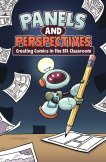
Over the last decade, comic books have transitioned from niche market to the engine of popular culture. This rise in the medium has prompted a discussion on the educational potential of comic books and graphic novels. While students may be versed in comic books and popular culture, classroom implementation is dependent on teacher familiarity with and literacy in comic books and culture. The materials below will provide you with media-rich resources to develop knowledge and promote English language learning through visual literacy.
Panels and Perspectives: Creating Comics in the English as a Foreign Language Classroom is an instructional guide to creating comics for educators of all English language learners. Presented in comic book format, Panels and Perspectives includes insights, strategies, and practical applications for making comics in any American English classroom to improve both language skills and critical thinking abilities. English teachers will discover there are many correct ways for students to create comics, whether they use photos, sketches, superheroes, or funny animals with superpowers to tell their stories.
How to order:
Outside the United States, print copies of this title may be requested by contacting the Public Affairs or Cultural Section of the nearest U.S. Embassy. We cannot guarantee, however, that all publications will be available at every office.
The Bureau of Educational and Cultural Affairs is prohibited from distributing its print materials in the United States by the Smith-Mundt Act.
Description:
Combining the written word with even the simplest doodles can be a powerful means for students to demonstrate their understanding. Panels and Perspectives: Creating Comics in the English as a Foreign Language Classroom is an instructional guide to creating comics for educators of all English language learners. Presented in comic book format, Panels and Perspectives includes insights, strategies, and practical applications for making comics in any American English classroom to improve both language skills and critical thinking abilities. English teachers will discover there are many correct ways for students to create comics, whether they use photos, sketches, superheroes, or funny animals with superpowers to tell their stories.
Here are some comic book resources to use in your classroom or home.
Zonk! Comics for the Classroom
Zonk 1 and Zonk 2, sponsored by the U.S. Embassy in Peru, created by professional comic illustrators Benjamin Ilka and Fabricio Rivas, showcase local talent from students and teachers across Peru. The goal is to get students and teachers excited about sharing their knowledge of local culture through comic book stories as a way to improve the language learning experience and enhance critical thinking skills. The stories come from communities across Peru, but they are intended to reach people around the world. The books have practical tips to adapt each story for use in your classroom or home.
Trace Effects Comics
Text: These comics follow Trace on his adventures throughout the United States. Geared toward young people, Trace Effects exposes users to American society and explores themes related to entrepreneurship, community activism, empowering women, science and innovation, environmental conservation, and conflict resolution.
Why English? Comics for the Classroom
The stories in Why English? Comics for the Classroom – written by teenagers and young adults – will appeal to learners of all ages. These stories provide an enjoyable opportunity to increase vocabulary, reading comprehension, listening, speaking, and writing. The stories and exercises together are a whole-language anthology designed to improve communication skills. This book provides exercises that employ the cooperative/collaborative learning philosophy and address multiple learning styles.
Teacher's Corner: Reported Speech
This lesson plan uses the Trace Effects comics.
COMIC BOOK TEACHING MATERIALS
Zonk! Comics for the Classroom
Zonk 1 (PDF)
Zonk 2 (PDF)
Trace Effects Comics
Chapter 1 (PDF)
Chapter 2 (PDF)
Chapter 3 (PDF)
Chapter 4 (PDF)
Chapter 5 (PDF)
Chapter 6 (PDF)
Chapter 7 (PDF)
Why English? Comics for the Classroom
Trace Effects Classroom Language Learning Activity: Reported Speech
Creating Comics to Think Critically
This session, "Creating Comics to Think Critically," provides strategies global educators can use to help English language learners create comics as a means of developing their language and critical thinking skills.
Using Comics in the English Language Classroom
Using comics in the EFL classroom is a terrific way to incorporate the target language in a fun, engaging way. This webinar demonstrates the universality of comics for any language classroom, showing how multi-skill comic activities can be used with students of all ages and ability levels.
Animating Your Instruction: Using Comics and Graphic Novels in the English Language Classroom
This session, "Animating Your Instruction: Using Comics and Graphic Novels in the English Language Classroom," explores the popularity of illustrated stories among teachers and students alike and offers suggestions on how to use them to “animate” your classes.
Teacher’s Corner: Comic Books for Learning
In this article, teachers will explore ways in which comic books can be used effectively in the classroom.
FORUM: Using Comic Strips in Language Classes
The author of this article discusses how comics can motivate younger learners, provide a context for language learning, and aid in comprehension through visual literacy.
FORUM: Student Storytelling through Sequential Art
This article provides helpful advice for teachers interested in using sequential art as a source of authentic reading material in their classrooms.
FORUM: Creating Cartoons: A Learner-Centered Approach to Comprehending Texts
This article carefully describes the technique of having learners create cartoons based on a reading passage to explore their understanding of the passage and to help teachers reflect on what the learners comprehended.